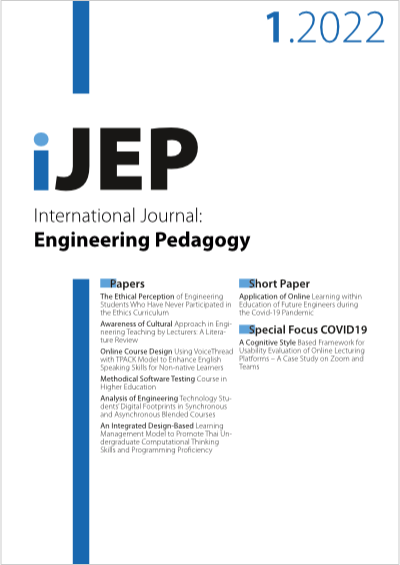Analysis of Engineering Technology Students’ Digital Footprints in Synchronous and Asynchronous Blended Courses
DOI:
https://doi.org/10.3991/ijep.v12i1.24571Keywords:
Blended learning, synchronous, COVID-19, asynchronous learningAbstract
The advent of Covid-19 provided an enormous academic and logistical challenge to almost all academic institutions in the United States and around the world. As a precautionary measure surrounding the novel coronavirus and in line with recommendations from the Center for Disease Control and Prevention (CDC) at that time (spring 2020), most higher education institutions in the United States shut down campuses and completed the second half of the spring 2020 semester virtually. During the fall 2020 semester, when relatively more was known about the virus, some institutions started with face-to-face classes but had to switch to virtual learning after noticing a spread of the coronavirus on their campuses. Others adopted a blended approach that supplements face-to-face meetings with virtual learning synchronously or asynchronously. Whichever approach adopted in place of the traditional face-to-face meetings did not necessarily solve the challenge faced by Engineering Technology programs, which typically infuse hands-on learning in most of the courses in their curriculum. Due to the applied nature of engineering technology, it is important to ensure that students stay engaged with creative ways to learn by doing. And to ensure that the students do not miss critical course content in virtual and blended engineering technology courses, it is vital that the students maintain high interactions with online resources such as class video recordings. This paper reviews students’ patterns of interactions with course videos to assess its impact on the academic success of engineering technology students in some upper-level blended courses delivered during the spring and fall 2020 semesters.
Downloads
Published
2022-02-10
How to Cite
Appiah-Kubi, P., Zouhri, K., Basile, E., & McCabe, M. (2022). Analysis of Engineering Technology Students’ Digital Footprints in Synchronous and Asynchronous Blended Courses. International Journal of Engineering Pedagogy (iJEP), 12(1), pp. 63–74. https://doi.org/10.3991/ijep.v12i1.24571
Issue
Section
Papers
License
Copyright (c) 2021 Philip Appiah-Kubi, Khalid Zouhri

This work is licensed under a Creative Commons Attribution 4.0 International License.



